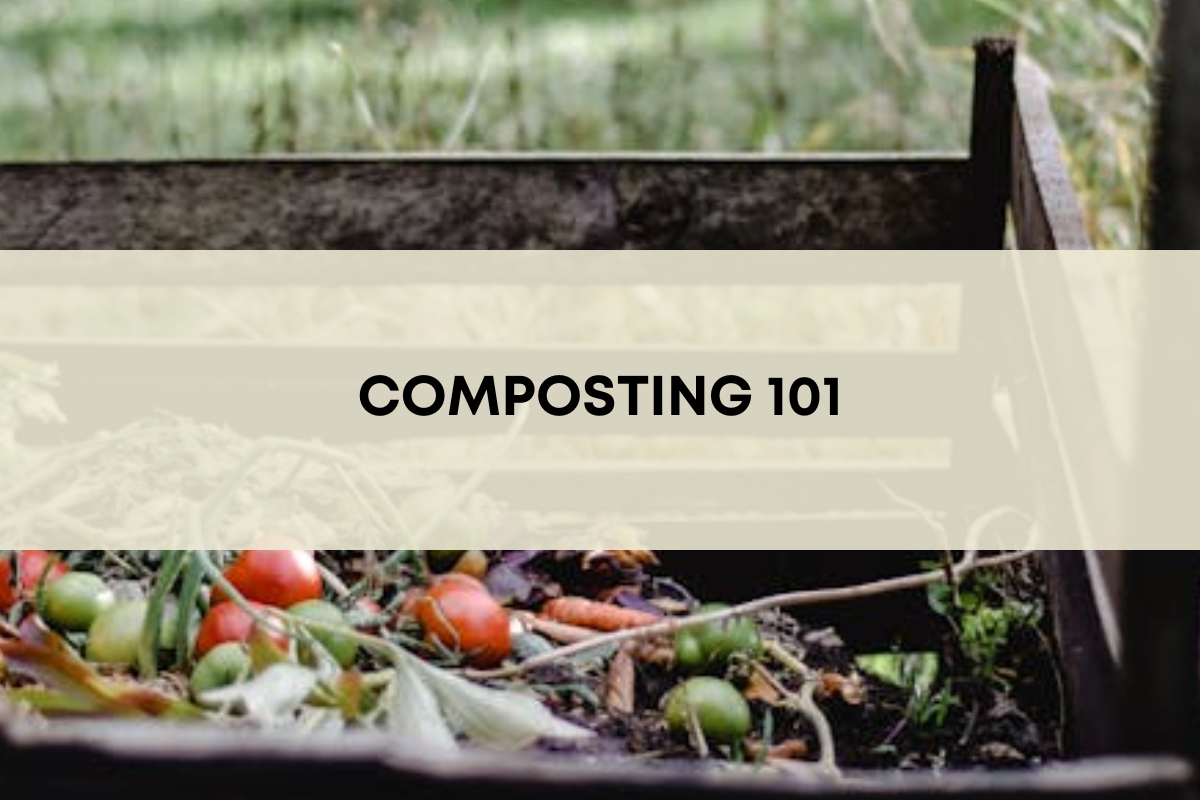Composting 101

The Zero Waste lifestyle, as inspired by Bea Johnson, is about decreasing your impact on the earth using the 5 R’s – refuse what you do not need, reduce with you do need, reuse by using recyclables, recycle what you cannot refuse, reduce, or reuse, and rot (compost) the rest.
Composting your food scraps is one of the most sustainable things that you can do. The more that I delve into composting, the more I learn about how positive the affects of composting are for our air, water, and soil.
Not sold? Here are my top five reasons to compost:
- Rotting food waste in a landfill generates methane gas, a greenhouse gas 23 times as portent as carbon dioxide in trapping heat within the earth’s atmosphere.
- Many types of natural resources (air, water, soil, etc) go into growing our food. By composting, you are closing the loop and putting those resources back into the environment.
- Food waste that goes into the landfill does not decompose because it is not exposed to enough oxygen or sunlight to do so. It slowly rots over time, generating methane gas.
- Instead of paying for soil, compost, fertilizer, plant food, etc. you will have nutrient-dense compost at your fingertips, saving you time, money, and energy when you need it for you backyard garden, potted plants, etc.
- All around the country, landfills are filling up. FILLING UP. By composting, you are diverting waste from the landfill and instead creating new soil that is usable.

Want to start your own composting system?
Composting is EASY. You literally throw your carrot tops, potatoes skins, lawn clippings, and banana peels into a container and in a few months you have soil. Okay, it’s not that easy, but it is pretty simple. Check out the visual below for a list of items that should and should not be added to your bin. And one tip – the smaller the food scraps, the quicker they will decompose. For additional tips, check out howtocompost.org.

Living in an apartment or other small living space?
If you are living in a small space but don’t want to throw your food scraps into the landfill, you can help by collecting your food scraps to turn into compost. Most people in a small space are worried that collecting their food scraps will make their place smell. But as long as your container seals, odor shouldn’t be a problem. To get started, choose a container to hold your food scraps. Your container can be as simple as a 5-gallon ice cream bucket with a lid, or something that is specifically made to hold organic waste, like this compost bin. Place all of your food scraps into your container.
Your next step is to find a place to take your scraps. A few options are:
- City drop off site. More and more cities in the USA have an organic collection site.
- Neighbor who wants your food scraps for their compost.
- Local farmer who wants food scraps to feed their livestock or add to their own compost bin.
- Community garden. Often community garden’s have communal compost areas and will take your food scraps.
If you can’t find anyone to take your waste, a system like a Bokashi might be for you. Bokashi composting is an anaerobic process that relies on inoculated bran to ferment your kitchen scraps. At one point in the process you will need a place to bury your fermented waste, so if you have a small patch of ground available to you, Bokashi might be a great option.
Have more space, such as a house and backyard?
Again, to get started, choose a container to hold your food scraps (indoor) and a second container to hold your compost (outdoor). When your indoor container is full, empty the contents into your outdoor container. If your outdoor container is self-turning, turn it whenever you think of it (you cannot turn it too much!). If you need to turn it by hand, get out there with your shovel whenever you can and manually turn the compost over so that all of your scraps are getting mixed together. The more you turn, the quicker your food scraps will turn into usable soil

You can get very technical with your compost, measuring out specific types of food and adding lawn clippings, leaves, water, etc. to get the perfect compost. Personally, I throw everything into one bin, turn it when I can, and in about a year I have usable soil for my garden and potted plants. Bea Johnson of The Zero Waste Home calls this “lazy composting” and I think that is the perfect name.
Here are products I recommend to help you in your composting journey:
- Upcycled Plastic Countertop Composting Bin
- Ceramic Compost Bin and their replacement Compost Bin Filters
- 3-gallon Compostable Bags
What are your thoughts on composting? Any tips or suggestions for others?
Are you local to the Twin Cities? Here are some additional composting resources.
- Organics Recycling for Residents of Hennepin County
- Organics Recycling Guide for Hennepin County - What you can and cannot put into your organics bin
- Ramsey County Collection Organics Recycling Information
Recent Blog Posts
Discover more tips on living #ZeroWaste!
-

How to Celebrate Earth Month: 10 Actions to Make a Difference
Earth Month is the perfect time to take action for the planet. In this post, we share 10 simple actions you can take this month to celebrate Earth Month and reduce your ecologic...
Read more -

Why Choose a Plastic-Free, Zero-Waste Lifestyle?
Plastic waste is everywhere, but small swaps can make a big impact. Reduce single-use plastic, shop in bulk, and choose sustainable alternatives. Tare Market is here to help you...
Read more -

Celebrating Women Makers: Women-Owned Brands at Tare Market
Celebrate International Women’s Day with Tare Market by supporting women-owned brands that are making a difference in sustainability and entrepreneurship. From eco-friendly clea...
Read more



